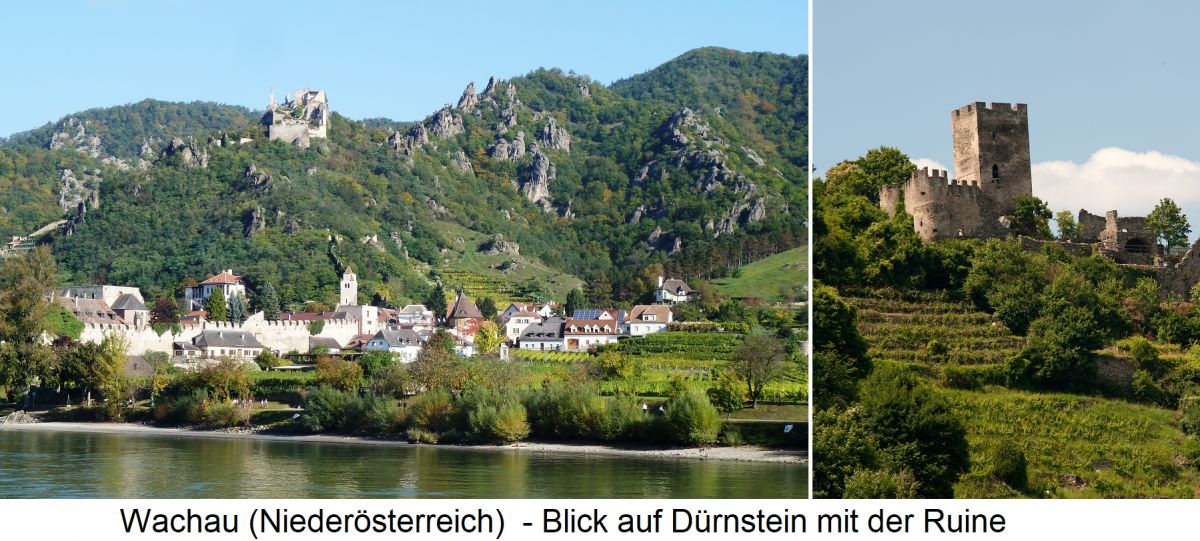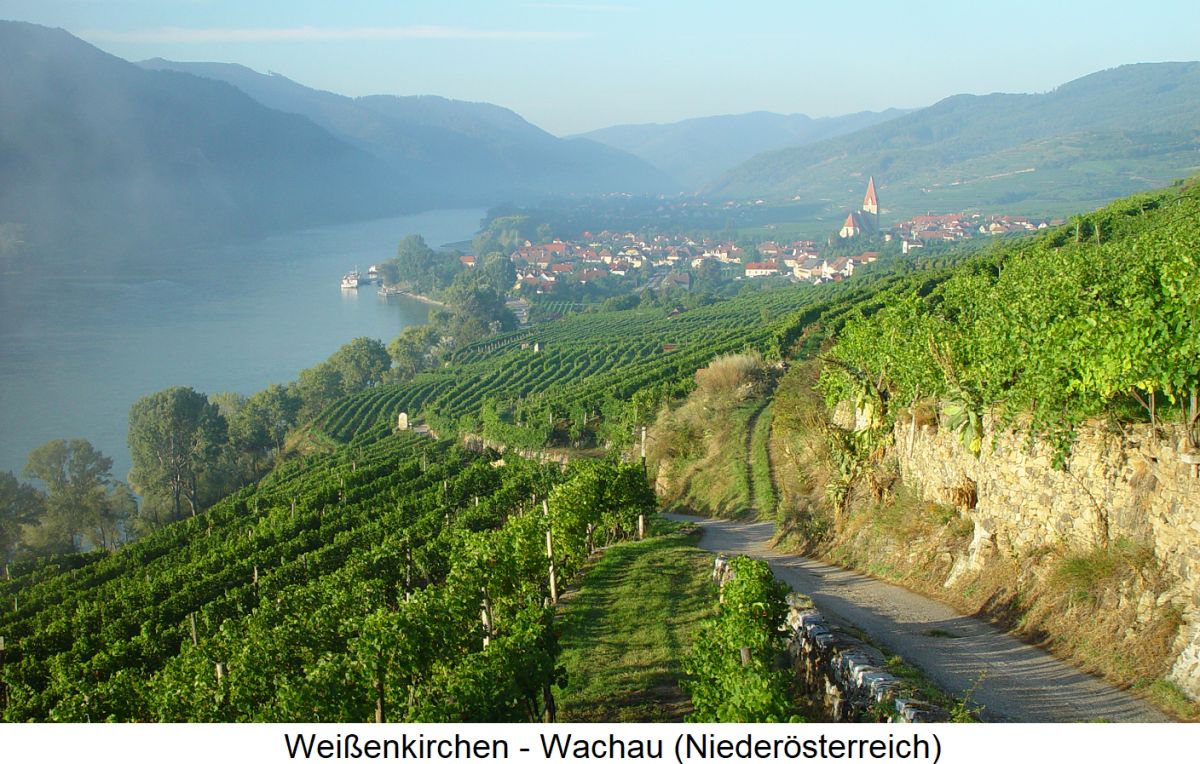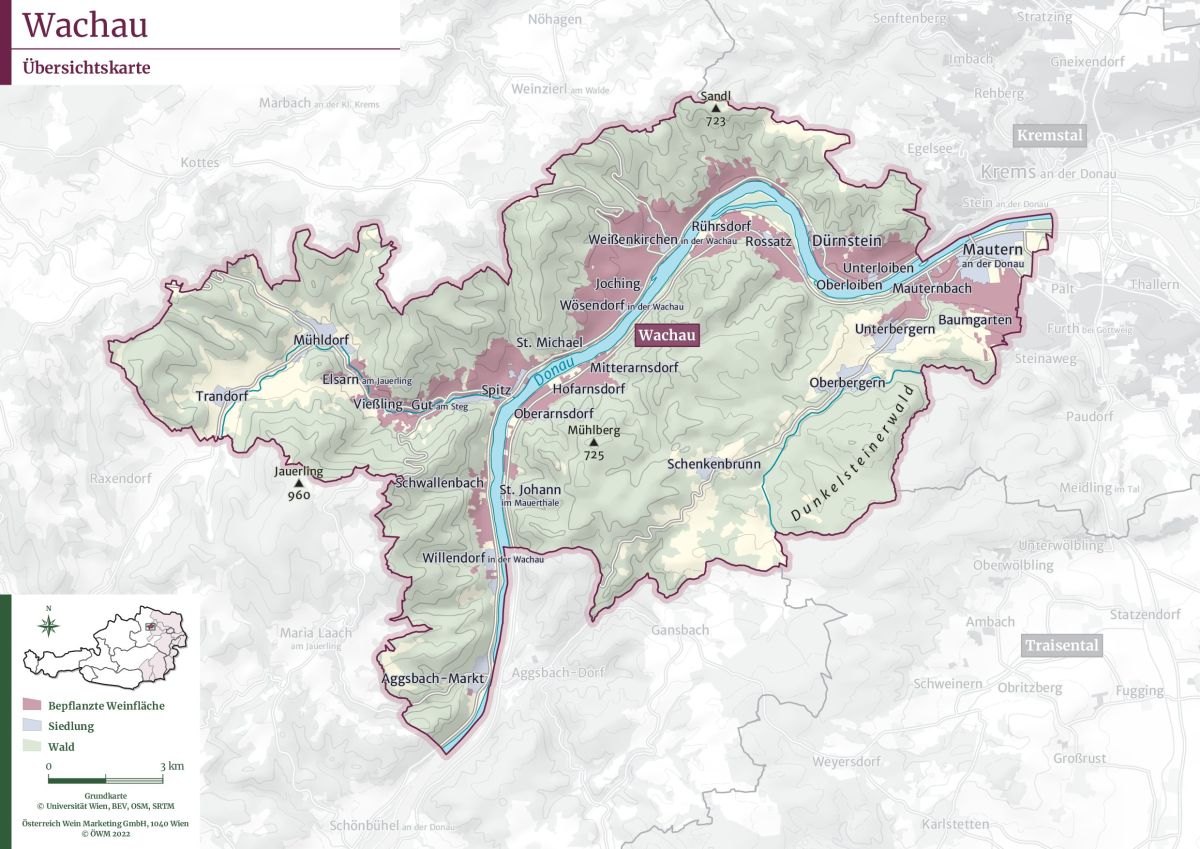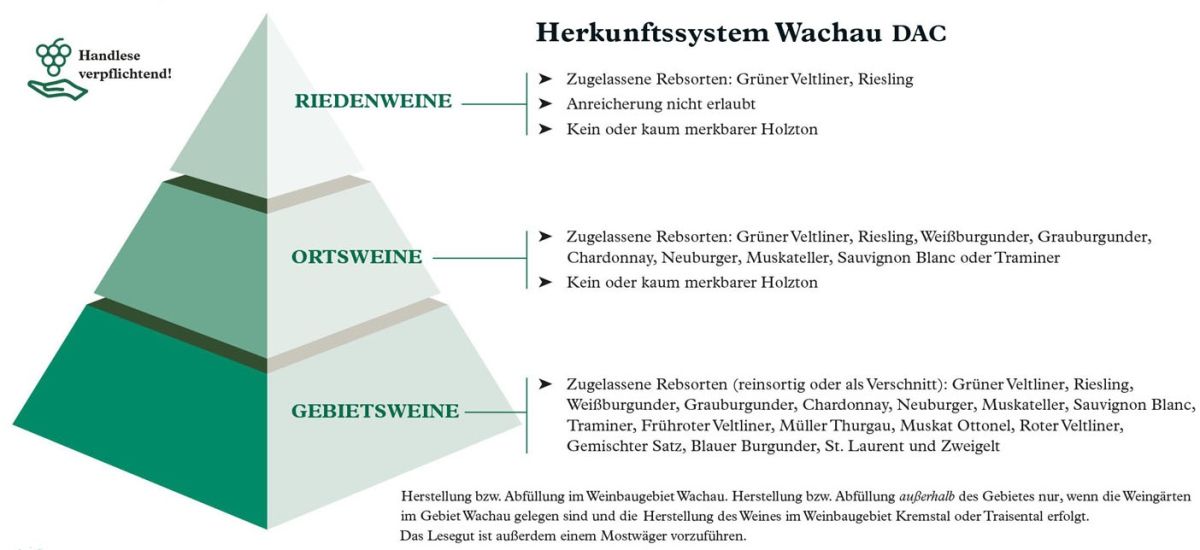Results
2,284 Results
Loading more Results ...
Loading more Results ...
| Wachau |
Description to Wachau
One of the eight specific wine-growing areas in the Austrian province or generic wine-growing region of Lower Austria. It is crossed by the Danube, on whose northern banks many of the mostly terraced vineyards are located. The vineyards, some of which are very steep, are among the steepest in Austria, 40% of which are fortified with dry stone walls. The narrow valley along the Danube is only 33, the wine-growing area 15 kilometres long. The gateway to the west is the Benedictine Abbey of Melk, and to the east it is bordered by the over 1,000-year-old town of Krems. The Wachau was designated a UNESCO World Heritage Site in the category "Cultural Landscape" in 2000, and in 2021 dry-stone walling was added to UNESCO's list of intangible cultural heritage sites as a traditional craft.

History
In the 5th century, the monk Severinus (410-482) lived near Favianis (Mautern) in the midst of vineyards, which proves that wine was cultivated. The English King Richard the Lionheart (1157-1199) was captured near Vienna on his return from the Third Crusade and held at Dürnstein Castle. King Henry II (973-1024) donated the small settlement of Liupna (Loiben), to the Tegernsee Monastery in 1002. Around 1900, the Viennese mayor Karl Lueger (1844-1910) served a Loiben wine at a ball to Emperor Franz-Joseph I (1830-1916), who commented: "I would not have thought that there was such good wine in my countries". Lueger then suggested the name "Loibner Kaiserwein".
The Benedictine Abbey of Melk owned vineyards not only in the Wachau, but also in the municipalities of Gumpoldskirchen, Pfaffstätten and Baden. In Rohrendorf near Krems, a vineyard of around 100 hectares is still owned by the monastery today; it was donated by Leuthold von Kuenring in 1113. In 1883, during the second Turkish siege of Vienna, wine from the Abbey cellar was used to extinguish a fire that had already spread to the church tower and threatened the bells. In 1703, 24,000 buckets of wine were stored in the cellars, the equivalent of 1.3 million litres! Finally, in the 18th century, the income from the tithe wine made it possible to rebuild Melk Abbey into the magnificent Baroque building it is today. Due to climate changes and strict levies, wine culture declined. It was not until the middle of the 19th century that top wines were again produced through the introduction of new varieties such as Veltliner and Riesling.

Climate & Soils
The terrain is mostly shallow with high and therefore heat-retaining mineral content. The soils are mainly made up of loess, sand and rigsols. In some terraced areas the humus layer is no thicker than 50 cm, below which there is bare granite. The Atlantic-Pannonian mixed climate is characterised by the moisture-giving Danube, which has a heat-increasing effect through reflection. An important factor for the special climate is the large temperature difference between day and night, which has a very positive effect on viticulture.
Wine-growing communities on both banks of the Danube
The Wachau wine-growing communities mainly extend to the left and some to the right of the Danube. Flohhaxn, Himmelstiege, Honivogl and Katzensprung are old vineyards that no longer exist and are now used as names for branded wines. The municipalities on the left bank with their vineyards are:
Dürnstein
The municipality comprises the cadastral communities Dürnsteiner Waldhütten, Oberloiben, Rothenhof and Unterloiben with the vineyards Heudürr, Höhereck, Hollerin, Kaiserberg (Subriede Lichtensteinerin), Kellerberg (Subrieden Wunderburg, Küss den Pfennig), Liebenberg, Pfaffenberg, Schlossberg, Schütt and Supperin.
Loiben
The municipality consists of the districts Oberloiben and Unterloiben with the vineyards Bockfüßl, Dinstlgarten, Frauenweingarten, Hochstrasser, Klostersatz, Kreutles, Loibenberg (Subrieden Langen Zung, Rauheneck, Rothenberg, Süßenberg), Mühlpoint, Oberhauser, Pichlhof, Rothenhof, Schütt, Setzen, Steinertal, Trum and Wandl.
Spitz a. d. Donau
The municipality comprises the cadastral communities of Gut am Steg, Schwallenbach and Viessling with the hamlets of Almenreith, Amtsgarten, Auleithen, Axpoint (Subriede Hochrain), Baumgartenthal, Brandstatt, Bruck, Burgberg(Tausendeimerberg), Bruck, Donaugarten, Fluiding, Gasslreith, Point-Gut am Steg, Setzberg (Subrieden Fischkasten, Landstallen), Hartberg, Kalkofen, Mühlgraben, Offenberg, Pluris, Singerriedel, Spitzer Birn, Spitzer Point, Steinborz, Tannen, Vogelleithen and Zornberg.
Weißenkirchen
The municipality comprises the cadastral communities of Joching, St. Michael and Wösendorf with the vineyards Achleiten, Altau, Angern, Buschenberg, Donauboden, Donaufeld, Frauengärten (Subriede Traben), Gaisberg, Harzenleiten, Hinter der Burg, Hinterkirchen, Hochrain (Subriede Ralais), Hinter Seiber, Kirchweg, Klaus, Kollmitz, Kollmütz, Pichlpoint (Subriede Pichl), Postaller, Ritzling, Steinriegl, Steinwand, Vorder Atzberg, Vorder Seiber, Weitenberg and Zwerithaler.

The communities on the right bank of the Danube are:
Bergern im Dunkelsteinerwald
The municipality comprises the cadastral communities of Geyersberg, Maria Langegg, Nesselstauden, Oberbergern, Scheiblwies, Schenkenbrunn, Unterbergern and Wolfenreith with Rieden Donauleiten (Subriede Galiziberg) and Laach (Subriede Steinplatte).
Mautern a. d. Donau
The municipality comprises the cadastral communities of Baumgarten, Hundsheim and Mauternbach with the vineyards Alte Point (Schlossberg sub-arrangement), Burggarten, Ladoschn, Prebarn, Raubern, Silberbichl (Bischofpoint, Kirschböck, Leukuschberg, Vom Stein, Zaum sub-arrangements), Strudel, Süßenberg and Weingebirge.
Rossatz-Arnsdorf
The municipality comprises the cadastral communities Mitterarnsdorf, Oberarnsdorf, Rossatz, Rührdorf and Unterarnsdorf with the vineyards Altenweg, Frauenweingärten, Brunnthal, Höckgarten, Hoferthal, Johannserberg, Mitterbirg, Mugler (Subriede Goldberg), Kellerweingärten, Kirnberg, Kreuzberg, Poigen, Pointen (Subrieden Obere Pointen, Untere Pointen), Porzen, Scheibenthal, Steiger, Siegelstal, Trauntal (Subriede Uiberthal) and Zanzl.
Grape variety list
In 2022, the vineyards covered a total of 1,324 hectares of vines. Compared to 2015 with 1,345 hectares, this was a reduction of 21 hectares (1.6%). The share of white wine varieties is 94%, the share of red wine varieties, which do not play a role in terms of quantity, is only 6%. The clearly dominant white wine varieties Grüner Veltliner and Riesling together occupy over four fifths of the total area. They are followed by Zweigelt, Müller-Thurgau, Muscat and Pinot Blanc.
Grape variety
|
in Austria
|
Colour |
HA
|
%
|
HA
|
%
|
| Grüner Veltliner | Weißgipfler | white | 836 | 63 | 766 | 56,9 |
| White Riesling | Riesling, Rhine Riesling | white | 238 | 18 | 355 | 17,4 |
| Zweigelt | Blue Zweigelt, Rotburger | red | 59 | 4,5 | 80 | 5,9 |
| Müller-Thurgau | Rivaner | white | 32 | 2,4 | 65 | 4,8 |
| Muscat Blanc | Yellow M., Red M. / Muscat Blanc | white | 32 | 2,4 | 26 | 1,9 |
| White Burgundy | Pinot Blanc, Klevner | white | 21 | 1,6 | 33 | 2,4 |
| Chardonnay | Morillon - not used in Lower Austria | white | 21 | 1,6 | 20 | 1,4 |
| Neuburger | - | white | 16 | 1,2 | 43 | 3,2 |
| Frühroter Veltliner | Malvasia | white | 8,2 | 0,6 | 13 | 0,9 |
| Sauvignon Blanc | Muscat Sylvaner | white | 7,8 | 0,6 | 7,3 | 0,5 |
| Pinot Noir, Pinot Noir | Pinot Noir, Pinot Noir, Pinot Noir | red | 6,3 | 0,5 | 4,4 | 0,3 |
| Blue Portugieser | - | red | 3,9 | 0,3 | 9 | 0,6 |
| Muscat Ottonel | - | white | 3,7 | 0,3 | 4,9 | 0,4 |
| Blauburger | - | red | 3,4 | 0,3 | 7,5 | 0,6 |
| St. Laurent | - | red | 3,1 | 0,2 | 7,4 | 0,5 |
| Traminer | Gewürztraminer, Red T., Yellow T. | white | 2,5 | 0,2 | 3,0 | 0,2 |
| Grey Burgundy | Pinot Gris, Ruländer | white | 2,5 | 0,2 | 1,9 | 0,1 |
| Roesler | - | red | 1,4 | 0,1 | 1,5 | 0,1 |
| Merlot | - | red | 1,3 | 0,1 | 0,8 | 0,1 |
| Cabernet Sauvignon | - | red | 0,9 | 0,1 | 1,7 | 0,1 |
| Roter Veltliner | - | white | 0,9 | 0,1 | 1,0 | 0,1 |
| Blaufränkisch | - | red | 0,8 | 0,1 | 0,9 | 0,1 |
| Flower muscatel | - | white | 0,6 | - | - | - |
| Goldburger | - | white | 0,3 | - | 0,3 | - |
| Welschriesling | - | white | 0,3 | - | 0,2 | - |
| Goldburger | - | white | 0,3 | - | 0,3 | - |
| Sylvaner | Green Sylvaner | white | 0,4 | - | 0,3 | - |
| Syrah | Shiraz | red | 0,2 | - | 0,2 | - |
| Rathay | - | red | 0,2 | - | 0,1 | - |
| Rose muscatel | - | red | 0,2 | - | - | - |
| Blue Wildbacher | - | red | 0,1 | - | - | - |
| Flower muscatel | - | white | 0,1 | - | - | - |
| Bouvier | - | white | 0,1 | - | 0,1 | - |
| Cabernet Franc | - | red | 0,1 | - | - | - |
| Furmint | - | white | 0,1 | - | 0,2 | - |
| Muscaris | - | white | 0,1 | - | - | - |
| Rotgipfler | - | white | 0,1 | - | 0,2 | - |
| Scheurebe | seedling 88 | white | 0,1 | - | 0,2 | - |
| Souvignier gris | - | white | 0,1 | - | - | - |
| Zierfandler | Late red | white | 0,1 | - | 0,2 | - |
| other varieties | - | white/red | 19 | 1,4 | 10 | 0,7 |
WHITE SORT |
|
white |
1.240 |
94 |
1.228 |
91 |
RED SORT |
|
red |
84 |
6 |
117 |
9 |
TOTAL |
|
|
1.324 |
|
1.345 |
|
DAC system
In August 2021, the origin-controlled quality level Wachau DAC was made compulsory from vintage 2020 (for vintage 2019 this was optional). All other quality wines must be marketed with the origin Lower Austria, the Land wines under the winegrowing region designation Weinland. In addition to the generally applicable DAC conditions, special rules apply. The quality wines produced under the brand name of WV Vinea Wachau Nobilis Districtus in the levels Steinfeder, Federspiel and Smaragd remain as designations. There is a three-level pyramid of origin with the levels of regional wine, local wine and estate wine. In principle, hand harvesting is mandatory for all wines.

Regional wines: The grapes may originate from the entire wine-growing region of Wachau. The white grapes Grüner Veltliner, Riesling, Pinot Blanc, Pinot Gris, Chardonnay, Neuburger, Muskateller, Sauvignon Blanc, Traminer, Frühroter Veltliner, Müller-Thurgau, Muskat-Ottonel and Roter Veltliner and the red grapes Pinot Noir, St. Laurent and Zweigelt, as well as cuvées thereof and Gemischter Satz are permitted.
Local wines: There are 22 protected local varieties (see above). The white wine varieties Grüner Veltliner, Riesling, Pinot Blanc, Pinot Gris, Chardonnay, Neuburger, Muscat, Sauvignon Blanc and Traminer are permitted. These must be vinified as single-varietal wines and must have no or hardly noticeable wood tones.
single vineyard winesThe grapes must come from 157 defined vineyards (sites). Only the two white wine varieties Grüner Veltliner and Riesling are permitted. The wines must not show any or hardly noticeable woody tones and must not be enriched. The levels Steinfeder, Federspiel and Smaragd are possible.
Producers
Well-known producers are Alzinger, Bäuerl Wolfgang, Bruch Richard, Dinstlgut, Domäne Wachau, Donabaum In der Spitz, Donabaum Sighardt, Eder Andreas, Eigl Christian, Fischer Josef, Frischengruber, Gallhofer, Gritsch Josef, Gritsch Mauritiushof, Gritsch Roman, Hick Maria & Manfred, Hirtzberger Franz, Hofstätter, Högl Josef & Georg, Höllmüller, Holzapfel Karl, Hutter Fritz, Jamek Josef, Kartäuserhof, Knoll Emmerich, Lagler Karl, Machherndl, Muthenthaler Martin, Nikolaihof, PAX, Pichler Franz Xaver, Pichler-Krutzler, Pichler Rudi, Pomaßl, Prager, Rixinger, Schmelz Johann, Schmidl Theresa, Schneeweis, Schneeweiss Anton, Schwarz Johann, Sigl Heinz, Tegernseerhof, Urbanushof Paul Stierschneider, Veyder-Malberg. Under the brand name Vinea Wachau Nobilis Districtus, quality wines typical of the region are produced according to strict quality criteria.
Map and DAC pyramid: Copyright ÖWM
Weißenkirchen: Egon Mark
Classified wine producers in Wachau 25
find+buy for Wachau 41
Recent wines 1740
 Rudi Pichler
— Lower Austria/Niederösterreich
2012 Wachau Ried Kirchweg Riesling Smaragd® trocken
89 WP
very good
Rudi Pichler
— Lower Austria/Niederösterreich
2012 Wachau Ried Kirchweg Riesling Smaragd® trocken
89 WP
very good

 Josef & Georg Högl
— Lower Austria/Niederösterreich
2012 Wachau Ried Tausendeimerberg Grüner Veltliner Smaragd® trocken
91 WP
excellent
Josef & Georg Högl
— Lower Austria/Niederösterreich
2012 Wachau Ried Tausendeimerberg Grüner Veltliner Smaragd® trocken
91 WP
excellent

 Weingut Piewald
— Lower Austria/Niederösterreich
2021 Wachau Grüner Veltliner Smaragd® trocken "Hoch Wachau®"
91 WP
excellent
35.00 €
Weingut Piewald
— Lower Austria/Niederösterreich
2021 Wachau Grüner Veltliner Smaragd® trocken "Hoch Wachau®"
91 WP
excellent
35.00 €

 Weingut Tegernseerhof
— Lower Austria/Niederösterreich
2012 Wachau Ried Loibenberg Riesling Smaragd® trocken
93 WP
excellent
Weingut Tegernseerhof
— Lower Austria/Niederösterreich
2012 Wachau Ried Loibenberg Riesling Smaragd® trocken
93 WP
excellent

The most important grape varieties
More information in the magazine
- White wine monuments and world heritage Wine-growing regions in Austria: Wachau
- In Focus: Grüner Veltliner The elegant ones are coming
- In Focus: Wachau The return of finesse
- Austria In Focus Wachau
- BEST OF Wachau Fiction and truth
- Austria In Focus Wachau
- Wachau The Spitzer Graben - Valley of Extremes
- Codex Wachau - Charter of Pure Wine or: Resistance is the vintner's duty
- The collections and discoveries of the year Tasting season 2023/2024
- The two unstoppables Blaufränkisch from Austria and Germany in comparison